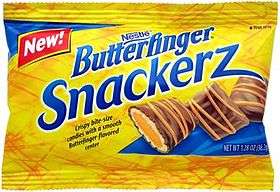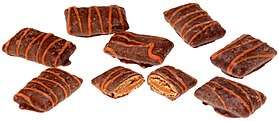Butterfinger
 | |
|
| |
| Product type | Confectionery |
|---|---|
| Owner | Nestlé (since 1990) |
| Country | United States |
| Introduced | 1923 |
| Related brands | Reese's Peanut Butter Cups, Clark Bar, 5th Avenue |
| Previous owners |
Curtiss Candy Company (1923–1964) Standard Brands Inc. (1964–1981) Nabisco (1981–1985) RJR Nabisco (1985–1988) Kohlberg Kravis Roberts & Co. (1988–1990) |
| Tagline | Crispety, crunchety, peanut-buttery! |
| Website |
butterfinger |
Butterfinger is a candy bar created in 1923 in Chicago, Illinois by Otto Schnering, which currently is manufactured by Nestlé. The bar consists of a crispy peanut butter core coated in milk chocolate.[1] Butterfinger has become known for its humorous marketing and a roster of memorably funny spokespersons, including Bart Simpson, Top Cat, Seth Green, Erik Estrada, Rob Lowe, and Jaime Pressly.
Other memorable ad campaigns include counting down the end of the world or BARmageddon, with evidence such as the first ever, QR shaped crop circle in Kansas, a Butterfinger comedy-horror movie called “Butterfinger the 13th,” the first interactive digital graphic novel by a candy brand starring the Butterfinger Defense League, and several attention grabbing April Fool’s Day pranks, including the renaming of the candy bar to “The Finger.”[2]
With 2010 sales of $598 million, Butterfinger has become increasingly popular and has typically ranked as the eleventh most popular candy bar sold in the $17.68 billion United States chocolate confectionery market between 2007 and 2010.[3]
History
The Curtiss Candy Company was founded near Chicago, Illinois, in 1922 by Otto Schnering, using his mother's maiden name. He invented the Butterfinger candy bar in 1923.[4] The company held a public contest to choose the name of this candy. In an early marketing campaign, the company dropped Butterfinger and Baby Ruth candy bars from airplanes in cities across the United States as a publicity stunt that helped increase its popularity. The candy bar also was promoted in Baby Take a Bow, a film from 1934 featuring Shirley Temple.
In 1964, Standard Brands Inc. purchased the Curtiss Candy Company. It then merged with Nabisco in 1981. RJR Nabisco was formed in 1985 by the merger of Nabisco Brands and R.J. Reynolds Tobacco Company. In 1988, RJR Nabisco was purchased by Kohlberg Kravis Roberts & Co. in what was at the time, the largest leveraged buyout in history.
In 1990, Nestlé, a Swiss multinational food and beverage company, bought Baby Ruth and Butterfinger from RJR Nabisco. When measured by revenues, Nestlé is considered the largest food company in the world.[5][6] In January 2018, Nestlé announced plans to sell over 20 of its U.S. confectionery brands (including Butterfinger) to Italian chocolatier Ferrero SpA for $2.8 Billion dollars.[7] This deal was finalized in March 2018.[8]
Nestlé advertising campaigns
Two of the slogans currently used to advertise the candy bar are "Follow the Finger" and "Break out of the ordinary!" Prior to these, Bart Simpson, Homer Simpson, and other characters from Fox's The Simpsons, appeared in numerous advertisements for the product from 1988 to 2001, featuring the slogans "Nobody better lay a finger on my Butterfinger!", "Bite my Butterfinger!", and "Nothin' like a Butterfinger!"
Butterfinger, for unknown reasons, terminated a long standing advertising contract with The Simpsons in the end of 2001. Reacting to this, the January 2002 Simpsons episode "Sweets and Sour Marge" included a scene depicting Butterfinger bars as nonflammable; the character Chief Wiggum says, "Even the fire doesn't want them."
In February 2003, in the episode "Barting Over", Bart claims he does not recall being in any commercials in the past, and then eats a Butterfinger just as he did in the commercials. In the November 2014 episode Simpsorama, a crossover with Futurama, Butterfingers are used to lure the Bart creatures into Madison Cube Garden.
On April 1, 2008, Nestlé launched an April Fool's Day prank in which they claimed that they had changed the name of the candy bar to "The Finger", citing consumer research that indicated that the original brand was "clumsy" and "awkward". The prank included a fake Web site[9] promoting the change that featured a video press release. When the joke was revealed, the website redirected visitors to the fictitious "Butterfinger Comedy Network".
In 2009, a new advertisement for Butterfinger was produced that appeared to be a homage to the earlier The Simpsons commercials. In 2010, Butterfinger revived its "Nobody better lay a finger..." slogan as "Nobody's gonna lay a finger on my Butterfinger."[10] In 2011, a comedy horror film entitled Butterfinger The 13th, was made to promote the product.[11] In April 2013, an official announcement via the Twitter account of The Simpsons stated that the "Nobody better lay a finger" advertising campaign featuring Bart Simpson would be returning.[12]
In the 2017 Treehouse of Horror XXVIII opening sequence, the family appeared to be candy in a bowl. Marge was a mars bar, Homer an Oh Henry bar, Lisa an apple, Maggie a candy ring, and Bart a Butterfinger bar. Bart tells his mother he is scared, Marge comforts him by stating he's always the last taken.
Variations


- Bites: A product with small, bite sized pieces of Butterfinger is called Butterfinger Bites.
- Snackerz: Butterfinger Snackerz is another bite sized, smooth centered version of the candy bar.
- BB's: Starting in 1992, another form of Butterfinger bars was available called BB's. Similar to Whoppers and Maltesers, they were roughly the size of marbles and sold in bags. They also were advertised by the Simpsons. They were discontinued in 2006. In 2009, the product was brought back as Butterfinger Mini Bites.
- Buzz: During the height of the energy drink craze in 2009, a two piece ‘king size’ version of the candy bar containing 80 milligrams of caffeine was released with limited distribution.[13] The wrapper bears this warning: "Contains 80 mg per package (40 mg per piece), as much as in the leading energy drink. Not recommended for pregnant women, children or persons sensitive to caffeine."[5]
- Ice Cream Bar: A product with an ice cream filling, the Butterfinger Ice Cream Bar, was introduced and continues to be sold in individual bags to this day. Another product similar to that of Butterfinger Ice Cream Bars, but shaped in a nugget form, also was developed and is now discontinued.
- Crisp: Nestlé also produces Butterfinger Crisp bars, which are a form of chocolate covered wafer cookie, with a Butterfinger flavored cream. This is part of a line of Nestlé products under a "crisp" name, including Nestlé Crunch Crisp and Baby Ruth Crisp.
- Cocoa mix: Nestlé released a hot cocoa mix with the flavor of the Butterfinger bar. The packaging advertises the cocoa as having a chocolate and peanut butter taste.[14]
- Cups: In 2014, a product similar to Reese's Peanut Butter Cups was introduced by Nestlé, the Butterfinger Peanut Butter Cup, which unlike Reese's Cups, has both crunchy and creamy peanut butter and covers the mix with milk chocolate.[15] It was the first new Butterfinger product introduced in more than five years. Nestlé spent two years developing the product.[16]
- Naked: The Naked Butterfinger is a version of the standard size candy bar that will only have a coating of chocolate on the bottom to hold it together.
- Dark: Made with Dark Chocolate
Use by other manufacturers
A part of Edy's Fun Flavors line (Dreyer's west of the Rocky Mountains and outside the United States). The product is vanilla ice cream with a peanut butter swirl and bits of the Butterfinger candy bar in it.
Grocery store Kroger has a flavor in their "Jammed" line called Peanut Butter Candy Crunch that is a peanut flavored frozen dairy dessert with Butterfinger chunks and a peanut butter swirl whose taste resembles that of the Butterfinger candy bar.
German GMO controversy
Butterfinger was withdrawn from the German market in 1999 due to consumer rejection when it was one of the first products to be identified as containing genetically modified ingredients (GMOs) from corn.[17][18] Butterfinger sales ended after a successful campaign by Greenpeace pushed Nestlé to remove the product from German supermarkets.[19]
Similar products, other manufacturers
- Clark Bar (from Boyer)
- 5th Avenue (from The Hershey Company)
- Reese's Crispy Crunchy Bar: a product that includes peanuts and peanut butter (owned by The Hershey Company)
- Zagnut: a similar product using toasted coconut instead of chocolate (from The Hershey Company)
- Chick-O-Stick: a rolled product using toasted coconut instead of chocolate (from the Atkinson Candy Company)
- Crispy Crunch (from Cadbury)
See also
References
- ↑ "Butterfinger". Nestlé USA. Retrieved July 14, 2016.
- ↑ "Butterfinger Celebrates 90ish Years Of Awesome-Ness" (Press release). Glendale, CALIF.: Nestlé USA. January 1, 2013.
- ↑ Chocolate Confectionery Brand Shares 2007–2010 (Report). Euromonitor International. 2010.
- ↑ Sanders, Dennis (1982). The First of Everything. Dell Publishing. p. 21. ISBN 978-0385282833.
- 1 2 "Nestlé's Brabeck: We have a "huge advantage" over big pharma in creating medical foods", CNN Money, 1 April 2011
- ↑ "Nestlé: The unrepentant chocolatier", The Economist, 29 October 2009. Retrieved 17 May 2012
- ↑ "Nestle selling U.S. candy brands to Nutella company". CNN. 2018-01-16. Retrieved 2018-01-16.
- ↑ "Ferrero Completes Acquisition of Nestlé USA's Confectionary Business". Business Wire. Business Wire, Inc. March 31, 2018.
- ↑ "The Finger Bar website". Archived from the original on 2008-07-02. Retrieved 2008-06-28.
- ↑ Butterfinger Ad Brings Back Slogan Archived 2013-04-09 at the Wayback Machine.
- ↑ Butterfinger the 13th on IMDb
- ↑ "The Simpsons on Twitter: "Bart Simpson reunites with @Butterfinger in Nestle's "Nobody Better Lay A Finger" campaign. Follow the reunion on Twitter! #LoveAtFirstBite"". Twitter.com. Retrieved 2016-01-30.
- ↑ Chris McNamara (February 18, 2009). "Butterfinger with caffeine generates some buzz".
- ↑ Butterfinger Archived November 10, 2015, at the Wayback Machine. at snackmemory.com
- ↑ "Butterfinger Cups". Nestle. Retrieved 2014-01-23.
- ↑ Jenn Harris (2014-01-15). "Butterfinger cups to launch with Super Bowl ad". LA Times. Retrieved 2014-01-23.
- ↑ Jung, Alexander (December 26, 2005). "What Can a Nation Do? Taming the Globalization Monster". Spiegel Online. Retrieved 2008-06-28.
- ↑ "Jugendliche bei Greenpeace" (in German). Greenpeace. May 15, 2003. Archived from the original on 2009-01-01. Retrieved 2008-06-28.
- ↑ K. Fahlenbrach; M. Klimke; J. Scharloth; L. Wong (2012). The Establishment Responds: Power, Politics, and Protest since 1945. Springer.
External links
| Wikimedia Commons has media related to Butterfinger. |